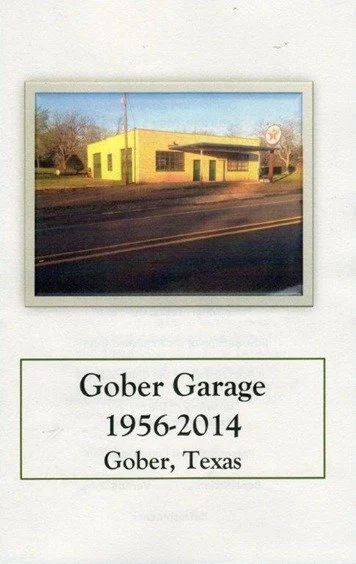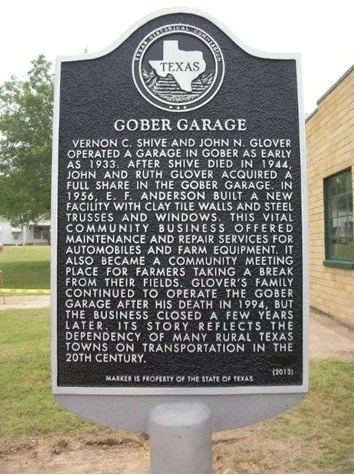Gober Garage
Marker Text:
Vernon C. Shive and John N. Glover operated a garage in Gober as early as 1933. After Shive died in 1944, John and Ruth Glover acquired a full share in the Gober Garage. In 1956, E. F. Anderson built a new facility with clay tile walls and steel trusses and windows. This vital community business offered maintenance and repair services for automobiles and farm equipment. It also became a community meeting place for farmers taking a break from their fields. Glover's family continued to operate the Gober Garage after his death in 1994, but the business closed a few years later. Its story reflects the dependence of many rural Texas towns on transportation in the 20th century.
I. Context
Settlers began to arrive in a small community located 10 miles SE of Bonham. The year was 1840. The town’s first name was Grittersville because it
was the home of one of the town’s first businesses, a steam powered gristmill. In 1845 it had a general store, a grist mill, a cotton gin and a post office. The first postmaster appointed to Gober was James Christian. The community experienced an increase in surrounding farms and in 1879 postal service was begun. (1)
In 1885 Jim Eads, Charlie Stafford and Lijah Peters helped lay off the present township and the name was changed from Grittersville to Gober in honor of J.F. & William Gober, the builders of the gristmill. (2)
By 1890, the number of residents had reached 250 and the number of businesses climbed to twenty-five. The Texas State Gazette & Business Director of the 1890’s recorded that Gober had a drug store, wood shop, undertakers, tailor and pressing shop, butcher shop, shoe shop and shoemakers, syrup mill, several blacksmiths, barbers, restaurant, ice company, saw mill, general mercantile store, a boarding house, several grocery stores, two churches and a school. (3)
A famous stone quarry, operated by Charlie Stafford was located at Gober. In 1888 the Fannin County courthouse at Bonham was constructed of limestone quarried at Gober. The stone was hauled in wagons pulled by mules to Bonham over rough roads. This stone was used in more than 20 counties in the state. (4)
On June 9, 1911, disaster struck the Gober community. Fire destroyed the buildings on the south side of Main Street. Fire struck again in the early
1920’s and the school was lost. Not long after, the gymnasium also burned. The school building and gymnasium would later be rebuilt. (5)
From 1900 until the 1930s, the limestone quarry operated six days a week and by 1930, the population of Gober had peaked at 300. Fire would strike again in 1946 and several buildings on the north side would be destroyed. With the coming of the Great Depression and World War II, the population began to decline and in 1956, there were only 200 people in Gober. The quarry operated part-time until 1960 and by 1966 the population had increased to 246 with five businesses; a school; four churches and one factory. The decline in population would lead to the school’s closing and consolidation with the Bonham ISD in 1969. On September 13, 1973, fire once again struck this small community and the school building was destroyed. In 1988 Gober had a reported 146 residents, one factory, two businesses and four churches. Gober would maintain this population in 1990s. (6)
During the next few years, the community would witness the loss of three churches; the school; and all but one business building – the Gober Garage. At the present time, there remains a post office; community center; a perpetual care cemetery; the Baptist Church and the Gober Garage. The garage
is located just east of what used to be the main part of town. Gober is located almost exactly half-way between the north/south Hwy 78 and Hwy 34. These two highways are connected by FM68 which was recently renamed in honor of a former speaker of the house. It is now officially known as “The Jimmy Turman” highway.
II. Overview
In 1945, a deed was recorded on behalf of John & Ruth Glover for the purchase of the existing business called The Gober Garage from V.C. Shives. On August 8, 1956, a contract was signed between John & Ruth Glover and E. F. Anderson for the construction of a new building for the sum of $6,182.70. In this contract the Glovers agreed to build one garage building, 50x52 feet; with tile walls, steel trusses, built-up roof and steel windows; 3 over-head doors 10x10 ft; and an awning on the front measuring 16x30 ft. This building was completed and has been preserved according to the original contract.
As one would expect, the Gober Garage became a vital part of the community. Providing services ranging from tire repairs to complete overhauls, the garage served not only the community but the entire county and adjoining counties for more than 50 years. It operated on “farm time” which is sun-up till sun-down 6 days a week. Located on FM68, it became a pivotal point in the community with a Texaco sign rising above the building on the west side with two fuel pumps under the awning where a person could purchase either “regular” or “ethel” gasoline. An air assisted hydraulic car-lift was originally located on the east side of the building but was later moved inside. The concrete slab on the east side is still there to mark the place of the original car lift.
The 16x30 ft. porch on the north side provided a drive-through convenience with water on one end and air on the other. It also provided a summer and winter meeting place for farmers who were taking a break from the fields. Two entrance doors were located on the north side, underneath the awning. The west door opened into the office and parts area. Water hoses and fan belts decorated the walls and parts bins were behind a counter which served to separate the office area. By the cash register was a box of small books – called ticket books. It was one of the first evidences of a “credit system.” When patrons came by for gas, parts or repairs, they would simply say, “put it on my ticket.” Most of the people had a “running account” or a ticket book with their name on it. Accounts were settled by the month and at times credit (free of interest) was extended on repairs to farm equipment until the crop was harvested. One farmer, who could not pay for a tractor overhaul, said that the credit that was extended to him, not only saved his crop, but enabled him to stay in the farming business.
In the outer office, there was a bench that had been donated by a local church. At the end of the bench was a “butane” (in those days) stove that provided much comfort on a cold day. The men who enjoyed the porch in the summer moved inside as the seasons changed. It provided a place to discuss everything from politics to a new-born puppy. Of course, the office also provided some goodies from the Lance jars and a fully stocked soft drink box. Many farmers looked forward to their 3:00 PM break for a moon-pie and a Dr. Pepper.
The east door under the awning led straight into the car lift and tire repair area. In the rear area there were several areas that were designated for various repairs. If you needed some welding done, you would go to the east back door and if you needed a state inspection, you would go to the west back door. Other areas provided space for motor overhauls and other auto/truck/tractor repairs. When parts were needed, it meant a trip to the auto stores in Bonham and occasionally to McKinney. Of course, there were no added charges for this travel expense. The Texaco consignee in Bonham provided the station with oil and gas.
When the Farm Bureau offered a franchise to sell Safe-Mark batteries and tires, the Gober Garage became their representative in the Gober Community and in that area of Fannin County. People came from all over the area to get their vehicles inspected and to buy tires and batteries. Of course, this was a time before Walmart and K-Mart and many of the “quick fix” auto stores. Steel racks, that reached from floor level to the ceiling, were constructed to hold the tires and shelves were built for the batteries.
For more than 50 years, the Gober Garage operated a State Inspection station. The sign that marked the entrance to that area is still attached to the west side of the building. It was always very interesting when a farm truck that had been sitting idle for months was brought in for inspection. It usually meant the removal of a lot of dirt daubers and an occasional wasp nest.
The Gober Garage continued to operate even after the death of Mr. Glover in 1994, finally closing its doors to the public in the late 90’s. The building
has been preserved with most of the tools and equipment still intact and usable. From the outside, Gober Garage looks very much the same as it has for
almost 60 years.
III. Significance
It is easy for a community to lose its identity. People move or pass away and new people move in, but the sense of community seems to be lost in the
transition. In a country community, landmarks were so important. Most directions of how to get from place to place involved the use of landmarks. Churches, cemeteries, post offices and businesses that are still standing in a community help the history of that community to be preserved. At the present time, Gober has a post office that has been threatened with closure; only one church still meeting; a community center; and a perpetual care cemetery. No business buildings remain except the Gober Garage. It maintains the same place and appearance that it has for over 50 years. It stands as a monument of the life and history of this community. Since it remains in the possession of the Glover family, every effort will be made to see that it is preserved as a constant reminder of the wonderful little community in Fannin County known as . . . Gober, Texas.
IV. DOCUMENTATION
(1) Texas Escapes Online Magazine – Gober, Texas
(2) Texas GenWeb – Gober, Fannin County, TX - pp.2-3
(3) Texas State Business Gazette
(4) Texas GenWeb – p.3
(5) Ibid – p.4
(6) Texas Escapes Online Magazine – Gober, Texas

